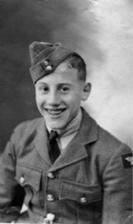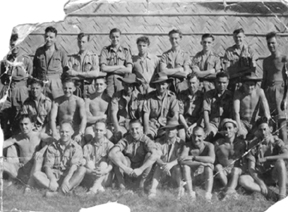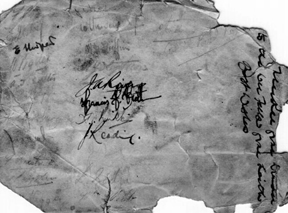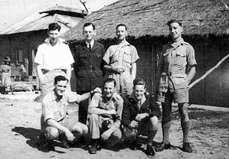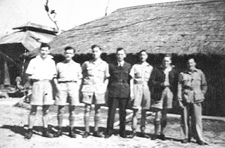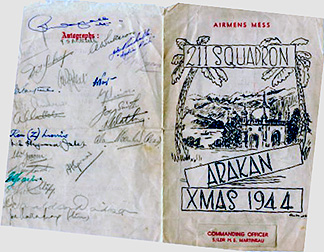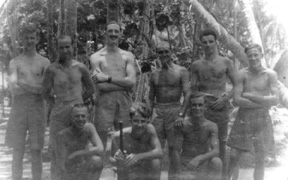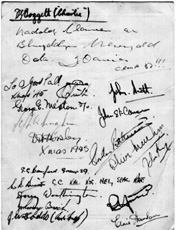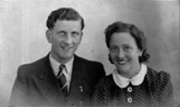 |
 |
|||||||||||||||||||
|
LAC J Robertson 1555691 RAFVR LAC 1555691 John “Robby” Robertson joined the RAF on 18 August 1941. Training at Blackpool as many groundcrew had, “Robby” mustered with the “plumbers”—the armourers. He found himself posted to RAF Waddington in time to bomb-up for one of the first 1000 bomber raids.
The young aircraftman in uniform before embarkation. Shipped out to the Far East on the Empress of Russia, he first joined 177 Squadron which had formed early in 1943 at Amarda Road, south-west of Calcutta. Like 211 Squadron, 177 Squadron equipped with Bristol Beaufighters, took part in the Burma campaign, and was stationed at many places familiar to 1943-onwards 211s including Phaphamau, Feni, Chiringa and Ranchi. During this period “Robby” joined 211 Squadron. It is from that time onwards that many of his photos come. Unbeknownst to fellow Scot John Stuart Robertson (taken captive in Java a year before and by now a PoW in Japan), another John Robertson had come to do his bit in 211 Squadron. In the later part of his time in the Far East, “Robby” left the Squadron and was posted to RAF Koggala in Ceylon, spending Christmas 1945 and the New Year there. Koggala was a major flying boat facility and at various times was home to 205 Squadron and its Catalinas and the Sunderlands of 230 Squadrons. One can only wonder whether the 205s, the 230s and an ex-211 like Robby realised how close their Squadrons had been in earlier days—both had had associations with 211 Squadron from Java and from Greece respectively. Demobbed in July 1946, he returned by ship to the UK only to find on arrival at Liverpool that the dockers, fearing tropical disease, refused disembarkation of the returning servicemen. A bit rich, considering how long many of the FE boys had had to wait to come home. LAC Robertson never forgot his treatment at the hands of the dockers. While “Robby” was one of those who rarely reminisced about the war to his family or others in civilian life, he did mention his mates from time to time: “Big Duncan”, “Griff”, and a “Nobby” Clark. Here too is another small coincidence in names. My own father was once also a “Nobby” Clark: he, however, had left 211 Squadron at the end of 1942 in the Middle East. In the RAF, as in the Navy, Clarks were as like as not “Nobby” just as Millers were like as not “Dusty”. Then again, one “Nobby” McGibbon was another mate of John’s. When he died six years ago, “Robby” had just taken part in the annual VJ parade. His son John (“Jammy”) recently found the 211 Squadron site and promptly wrote offering his late Dad’s photographs. These, with a small scrap book carefully compiled back on “civvy street” but then resolutely put away, tell another side of the story. For his group shots and menus, “Robby” got every man to sign the back, while his long-stored scrap book contains a rich collection of memorabilia, from Vera Lynn’s autograph to beer labels from Palestine to Edinburgh, with a telegram from his brother who was in Bombay at the same time, careful drawings from his armourer’s courses, and unit entertainment programmes with “Robby” as stage manager. Among the photo collection is the 211 Squadron Armourer’s Section shot also to be found in Alf Wythe’s set in the Burma Quintet, as well as two other shots that were clearly taken on the same occasion as one of Sam Spicer’s.
(Robertson family collection via R Humphreys) John Robertson is the shortest airman, 2nd from the left in the standing group. Given John’s various postings, it’s not possible to identify date or place with any confidence—likewise the other participants (though once again the beloved Akubra “bush hat” of Aussie and other FE servicemen is much in evidence). The aircraft is firmly identified, however, as Beaufighter X NV127, one of a batch of 500 built by Bristol at Weston-super-Mare. Beaufighters were ferried from the UK to the Far East, an experience shared by 211 Squadron aircews like Alan Carter, John Oblein and EL Wood. Thus did NV127 pass from 1 Ferry Unit to 177 Squadron in Burma, surviving with them until March 1946. At first glance in natural metal finish or perhaps the dark green overall plus white tailfin/tailplane combination used for a period in the Far East to provide both camouflage and recognition, the aircraft is in a weathered state. Other examples of this photograph have appeared (Airfix Magazine January 1970, eg) with a fuller frame view, which clearly shows the tropical camouflage pattern also used in the Far East extending over the rudder in the usual style. Two-tone roundels without the red centre are in use. The serial number though obscured in shadow, ends in 27. The building in the background is faintly reminiscent of Chiringa, though 177 Squadron were posted to many other familiar places. AWM Photograph database pictures of 211 Squadron aircraft at Chiringa in December 1944 show a different paint scheme in every essential, including roundel style, code letter placement, and camouflage scheme. Still, although not especially sharp, a very evocative Beaufighter shot.
Untitled and clearly a much later shot than the 1941 portrait. Here in tropicals, still with an irrepressible grin.
The cricket team in Celyon. Perhaps 1945, rather than 1944?
Signed by Charlie Doggett, J Davies (with Welsh motto), George Meston, John Scott, D Horsley, GC Bamford, Doug Worthington, JW Dodds, Eric Hanlon and many others. There are references to Group 37 and Group 39. There’s no obvious presence of 205 Squadron or 230 Squadron men, though both were based at Koggala. Nor are there any obvious associations with 211 Squadron, other than Robby himself.
From John’s scrapbook.
A wonderful shot of two mates to finish with. John (R) and “Griff” Griffin (L), in their best tropicals, in a shady and vaguely classical studio setting. Clearly the Aussie-style bush hat was the favoured headgear of “the Burma lot”, wherever they had been born and whether RAAF or RAF in origin. Inscribed from one mate to another: “Here’s to us, all on’us, May we nivver want nowt, none of us, And me neither. To Robby from Griff” Sources
www.211squadron.org © D Clark & others 1998—2025 |
|||||||||||||||||||
